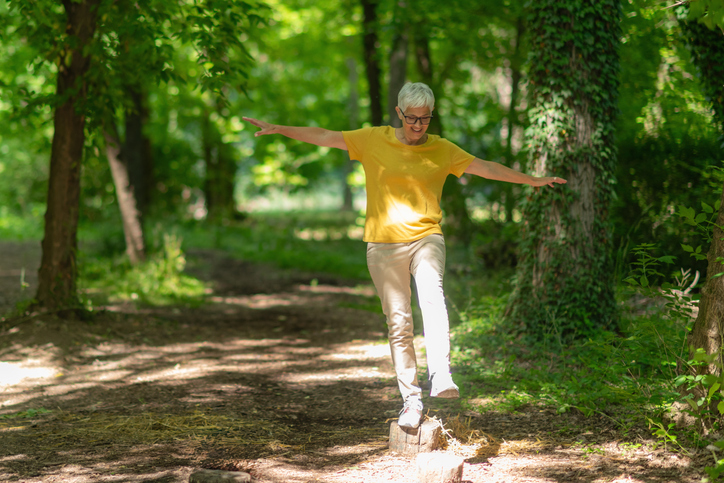By Nancy Alexander, PT, CSCS
October is recognized as Fall Prevention Awareness Month, and some organizations also link it to National Physical Therapy Month, focusing on falls prevention. It’s an awareness campaign to educate you on how to reduce falls through home safety modifications, regular physical activity, and health check-ups. Here we will share some facts about falls and how you can help reduce your risk.
According to the U.S. Centers for Disease Control and Prevention (CDC), an estimated 1 in 4 older adults fall each year. Falls are the leading cause of fatal and non-fatal injuries among older adults. In 2021, falls caused 38,000 deaths among those age 65 and older.
“Women are more likely to fall than men, but men are more likely to die from a fall than a woman,” according to Harvard Health. “Falls often result in brain injuries, hip fractures, immobility, and even early death.”
It’s easy to feel like a victim if you experience a fall. But let’s change the narrative. It comes with knowing that you can do something to decrease your fall risk. It comes with knowing that you have the power to improve your health and your safety, right here and right now. Let’s get started.
Home modifications
Many fall hazards are right in your own home, and a few inexpensive changes could lower your fall risk. Here are some ways you can help reduce the risk of falls in your home:
- Install handrails along indoor and outdoor steps and staircases.
- Use nonslip rugs and mats in your home including the bathtub. Make sure treads on stairs are well-maintained and secure.
- Install grab bars in the bathroom at your shower, tub, and/or toilet. Towel racks should never be used to prevent a fall as they are just not sturdy enough. Grab bars, when installed properly, are attached to wall studs for maximum safety.
- Remove clutter in all traffic areas and be sure floors are free of items that could be trip and slip hazards such as magazines, papers, and even wires.
- Keep traffic areas well-lit and install night lights in areas where you are likely to walk in the middle of the night.
Regular physical activity
I cannot more strongly emphasize that you need to move and keep moving. If you are not sure where to start, consult with a physical therapist. They can devise a program to get you moving safely while meeting your health needs. Here are some other ways to move:
- Engage in exercises that help improve your strength and balance and make them a consistent part of your exercise routine.
- Practice simple activities such as standing from a chair and sitting back down. Try to not rely on your arms to perform this activity, if possible. At the very least, reduce your need to use them. Do this activity slowly and always land in control.
- If you enjoy exercising in a pool, work on balance training there where you can challenge yourself more than perhaps you would on land.
- Try a Tai Chi class and experience the balance-building nature of this movement.
- If you can, maintain your ability to get up from and get down to the floor regularly without assistance.
- If you have decreased bone density and have osteoporosis or osteopenia, you are at a higher risk for fracture than someone without it. Strengthening your bones with weight-bearing exercise, impact, and resistance training are critical for you to protect your bones.

Health check-ups
As always, please consult with your physician if you notice any changes in your health and make sure that any exercise program you want to do is safe given your health status.
Discuss your risk of falling with your physician. Did you recently start a new medication or was a dosage changed? Did these coincide with a change in your mobility? Either one of these can impact your balance and your physician can help you review your medications and identify those that might cause you to be dizzy or unsteady. Your pharmacist can help with this as well.
Consult with other healthcare providers, too, such as your optometrist to be sure your vision is corrected appropriately, if necessary. Your vision and your hearing can affect your risk for falls. Follow-up with your specialists as needed for cardiac care or respiratory concerns. Regular check-ups are critical for your continued good health, function, and movement.
Start now
You have the power to reduce your risk for falls. Act now by assessing your environment and make home modifications as needed. Exercise regularly – with purpose – to improve your mobility and safety. Consult with your team of physicians and movement specialists for the best plan for your health that is specific and made just for you. Protect yourself and your independence by staying strong and steady.
Sources:
Harvard Health: https://www.health.harvard.edu/promotions/harvard-health-publications/preventing-falls
National Council on Aging: https://www.ncoa.org/article/get-the-facts-on-falls-prevention/
U.S. Centers for Disease Control and Prevention: https://www.cdc.gov/steadi/media/pdfs/STEADI_ClinicianFactSheet-a_1.pdf

Nancy,
I’m enjoying your fall sessions and I am grateful for the valuable educational information you share with us regularly.
Taking your classes since you came to Apollo Beach has been so beneficial to my sense of balance and wellbeing.
You are a truly an inspiration and blessing to those around you.
Thank you Diane. You work so hard and deserve all the good fortune that comes your way. You are a blessing to me and this community. Best wishes always, Nancy.